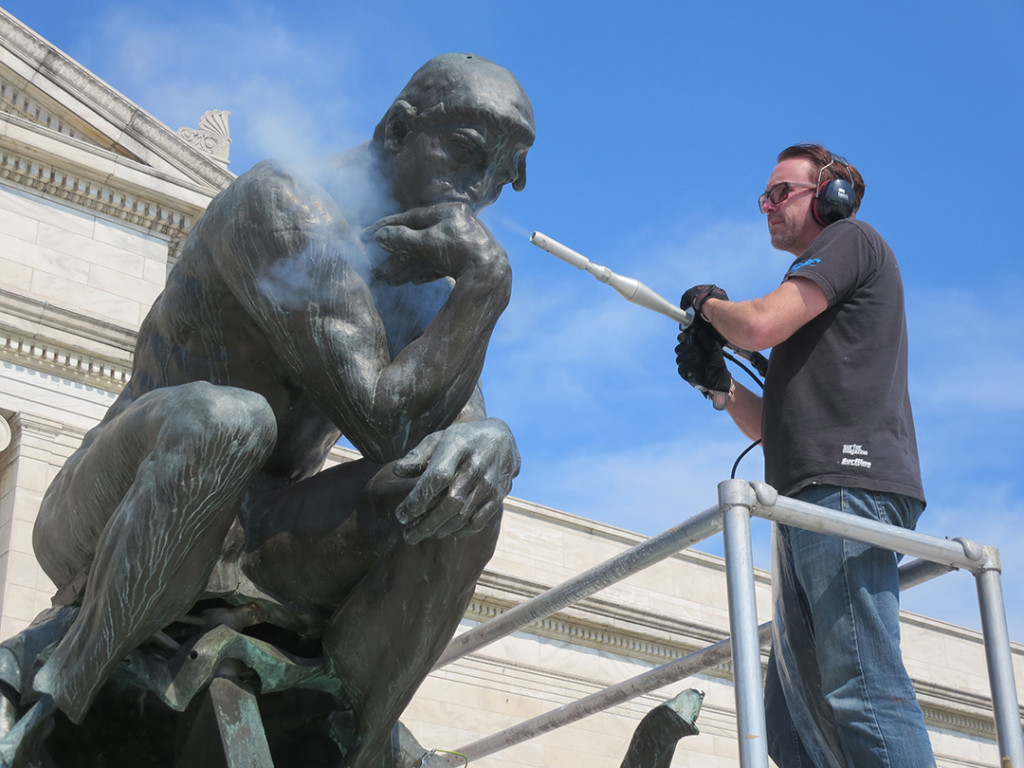Art Conservation Cleveland, Dry Ice CO2 Blasting, Outdoor Sculpture Conservation:
During the summer of 2014, McKay Lodge Art Conservation Laboratory was contracted to work with the conservators at the Cleveland Museum of Art to remove a failed protective coatings and reapply new ones to three sculptures, including Rodin’s iconic sculpture The Thinker. Similar work was performed on all outdoor sculptures and cleaning by use of solid carbon dioxide dry ice (CO2) blasting was a successful approach. For Rodin’s The Thinker conservation project and others we use our own IceTech blast machine (Continental Carbonic).
The surface of The Thinker appeared dull, lifeless, and strongly marked by streaking. The old duplex protective coating of Incralac (a common protective coating used for the protection of outdoor bronzes) and wax had begun to blanch and was nonexistent on the upper facing portions of the artwork. A new protective coating had to be applied to protect the patina from further reaction with the atmosphere and pollutants. Because a two stage or duplex coating of microcrystalline wax over an acrylic, clear coating had been used, the old and failing coatings had to be removed first.
Before the introduction of dry ice solid carbon dioxide CO2 blasting technology, the outdoor sculpture would have been cleaned using toxic solvents to remove the protective coatings. Incralac and wax solubilize in different solvents so in essence you have to solvent clean the sculpture twice. This process is laborious and creates health and environmental hazards. CO2 (or “dry ice”) cleaning, on the other hand, requires no use of solvents, creates no environmental damage, and the coatings can be removed from the surface of the sculpture with no damage to the existing patina.
Dry Ice Blasting is a dry process with no water waste, no chemical concern, and no secondary waste. So how does CO2 blasting work?
CO2 cleaning involves three primary factors: kinetic energy, thermal shock, and the kinetic-thermal effect.
Kinetic Energy: Incorporating specially designed high-velocity nozzles, pellets about the size of rice are propelled at the substrate surface using compressed air. These pellets are quite soft and do not have the density of harder more common blasting media like sand, glass beads or even walnut shells. The pellets change from a solid to gas almost instantaneously upon impact that provides an almost abrasion free blasting process.
Thermal Shock: The thermal shock effect occurs once the dry ice impacts the coating. The pellets that are -109 F (-79 C) absorb a massive amount of heat from the coating. The temperature of both the coatings layer and the substrate decreases. The different materials contract unequally and the adherence between them decreases causing the bond between them to fail.
Thermal kinetic effect: The combined impact energy and almost immediate heat absorption between the pellet causes the instantaneous conversion of the solid CO2 into gas. The gas expands to nearly 800 times the volume of the pellet within a few milliseconds. This causes an “explosion” at the point of impact. This creates an “explosion shock front” that is a very effective lifting force that will carry particles away from the surface.
By using CO2 blasting the coatings were removed from the outdoor sculpture in a matter of hours, not days, with no damage to the patina, no creation of hazardous waste, and no health concerns.
For more information on dry ice solid carbon dioxide (CO2) blasting:
Cleaning a bronze sculpture at the Freer Gallery of Art
ICE COLD – Symposium on dry ice solid carbon dioxide (CO2) cleaning



